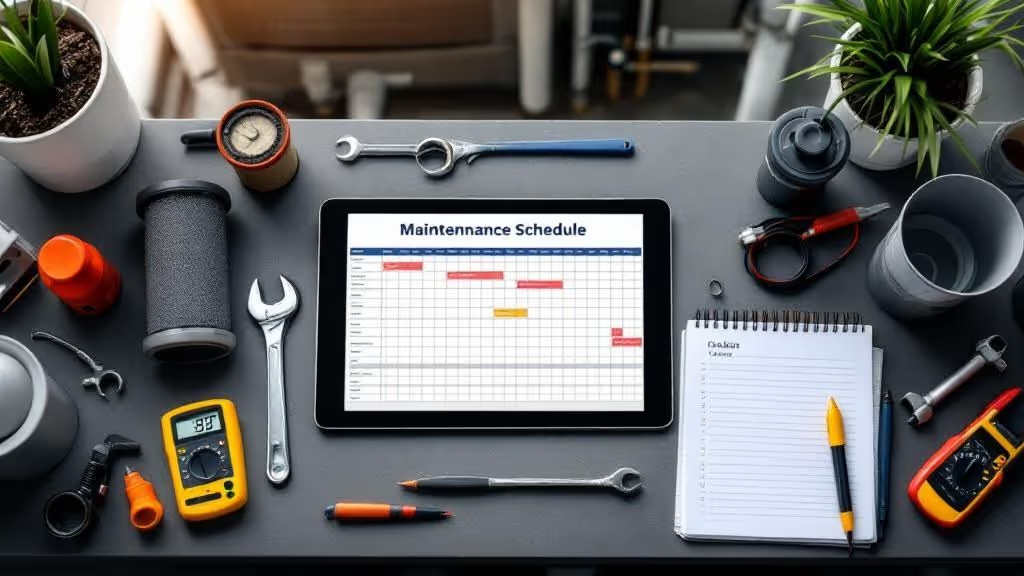If you want to get a handle on your invoice processing, you first need a brutally honest look at what your current system—or lack thereof—is actually costing you. For any field service business, sticking with old-school manual methods isn't just about shuffling paper; it's a direct hit to your cash flow and a massive time suck for your team.
The Hidden Costs of Manual Invoicing

Before you can solve the problem, you have to see it for what it is. Clinging to manual invoicing creates friction at every single touchpoint. Just imagine your best technician wrapping up a tough job, only to waste time fumbling with a messy paper invoice. That same invoice then lands on a desk back at the office, where someone has to squint to read it and punch every detail into a spreadsheet.
This whole song and dance is painfully slow and practically invites errors, which then ripple through your entire operation. A single misplaced decimal or the wrong service code can easily turn into a disputed invoice, damaging a customer relationship and pushing payment back by weeks.
The Real-World Impact
The real costs of these inefficiencies are shocking when you add them up. These are the kinds of problems I see eating away at profits all the time:
- Payment Disputes: Simple data entry mistakes are a top reason for confused clients and disputed payments. This forces your team to spend hours they can't bill for just to sort things out.
- Delayed Cash Flow: A huge bottleneck is slow internal approvals. An invoice sitting in a manager's inbox waiting for a sign-off is money your business desperately needs but can't access.
- Wasted Labor: Every minute your team spends on repetitive admin work is a minute they aren't focused on bringing in new business or serving customers.
Here's a number that should get your attention: about 39% of all manually processed invoices contain errors. What's more, the average cost to process just one invoice is around $15. If you're handling hundreds of invoices a month, that quickly snowballs into thousands of dollars in lost revenue and wasted time.
To truly get ahead of these hidden costs, it’s also wise to look at solutions that reduce the financial risks you face with standard payment processing, like the services offered by RiskPay. Once you've identified these pain points, you'll have a rock-solid case for adopting a modern, more profitable way of doing things.
Preparing Your Business for Automation

Bringing a tool like Nora into your field service business isn't just about adding new software—it’s about fundamentally changing how you operate for the better. But a successful switch doesn't start on launch day. It starts with some smart prep work.
First things first, you need to take a hard, honest look at your current invoicing process. Get a whiteboard or a spreadsheet and map out every single step. I mean everything, from the moment your technician finishes a job to the point that cash is finally in your bank account.
This little exercise is incredibly revealing. You'll start to see exactly where things get bogged down. Is it the time it takes for techs to drop off messy paperwork? Or the hours your office staff spends trying to figure out what a scribbled part number means? You can't streamline invoice processing until you know exactly where the bottlenecks are.
Standardize Your Services and Pricing
One of the biggest culprits of invoicing headaches is inconsistency. If one tech writes "system flush" on an invoice and another calls the same job "line cleaning," you've got a recipe for confusion, customer questions, and payment delays.
Before you go any further, create a master list of all your services, the parts you use, and what you charge for them. This list becomes the one and only source of truth for your entire operation. Getting this right ensures every invoice is clear, consistent, and professional, no matter who’s on the job site. It’s a simple change that makes a massive difference.
A quick tip from experience: Don't just hand your team a new tool and expect them to love it. Change can be unsettling, but resistance usually stems from not understanding the 'why.' Explain how this shift gets rid of their most annoying tasks and helps the whole company run smoother.
Get Your Team Ready for Change
When you explain the benefits in a way that resonates with their daily frustrations, you can turn hesitant team members into your biggest champions. This isn't about replacing people; it's about getting rid of the grunt work nobody wants to do.
Frame it around what's in it for them.
- For your techs in the field: Imagine no more piles of paperwork at the end of a long day. Just a quick photo or a voice note sent to Nora, and they're done.
- For your office staff: Think about it—no more hounding technicians for job details or trying to solve the mystery of illegible handwriting.
Lay out a clear plan, provide some hands-on training, and be there to answer questions. A bit of effort upfront to get everyone comfortable will pay off massively, ensuring you can all start to streamline invoice processing as a team from the get-go.
Getting Nora Dialed in for Your Business
 This is where the magic really starts. Setting up Nora isn't about cramming your workflow into a pre-built box. It’s about shaping the software around how your field service business actually works. The whole point is to create an invoicing process that feels custom-built for your team.
This is where the magic really starts. Setting up Nora isn't about cramming your workflow into a pre-built box. It’s about shaping the software around how your field service business actually works. The whole point is to create an invoicing process that feels custom-built for your team.
The most important first move is linking Nora to your financial software. Whether you live in QuickBooks, Xero, or another accounting platform, this connection is everything. A solid two-way sync means customer details, invoices, and payment updates move between systems on their own. This completely gets rid of double-entry and keeps your financial records accurate without you lifting a finger.
You'll see a setup screen, like the one pictured, that makes this initial connection straightforward. Getting this foundation right is what makes faster, cleaner invoicing possible for your whole operation.
Customizing Rules and Roles for Your Crew
Once the main connection is live, you can start setting the ground rules for your team and specific situations. Let's be real—not everyone needs access to everything.
You can create user roles that match your company's structure. For example, a technician in the field might only need to add job notes and track parts used. Meanwhile, your office manager gets the permissions to review, tweak, and send the final invoice. This kind of specific control is great for preventing simple mistakes and protecting sensitive financial data.
One of the most powerful things you can do is set up automation rules. Think about it: a rule that automatically adds the right sales tax based on the job's zip code. Or one that flags any invoice over $2,000 for a quick manager review before it's sent. These small tweaks save a ton of time and prevent expensive errors down the road.
Creating Invoices That Look Like You
Your invoice is often the last thing a customer sees from you, so it needs to look sharp and be dead simple to read. Nora helps you go way beyond a generic template. You can design invoices that feature your company logo, colors, and overall brand identity.
- Custom Line Items: Get all your common services and parts pre-loaded into the system. This makes building an invoice as simple as point-and-click.
- Clear Payment Terms: Spell out due dates and how you accept payments so there’s no guesswork for the customer.
- Automated Reminders: You can set up friendly, automatic follow-up emails for invoices that go past their due date. This one step can dramatically improve cash flow without forcing your staff to chase down payments.
This push for automation is happening everywhere. The global market for this type of software was recently pegged at $33.59 billion and is projected to hit $40.82 billion next year. That growth is coming from businesses like yours that are tired of shuffling paper and ready for a smarter way to work. You can read more about the shift toward automated invoicing on TheBusinessResearchCompany.com. This isn't just a fleeting trend; it’s a real change in how successful companies get things done.
From the Job Site to the Client's Inbox: Automation in Action
Let’s walk through what this looks like in the real world. Imagine one of your best HVAC techs, Sarah, has just wrapped up a complex repair. Instead of fumbling with a crumpled carbon-copy invoice book in her van, she pulls out her phone and opens the Nora app.
With a few taps, she marks the job "complete." She quickly adds a note about a specific condenser fan motor she installed and confirms her labor hours. That's it. She’s done.
The moment she hits save, Nora kicks into gear. It automatically pulls the pre-set price for that specific motor, calculates Sarah's labor based on her logged time, and compiles a clean, professional, and perfectly itemized invoice. This isn't just a concept; it's how top-performing field service businesses have eliminated the frustrating gap between finishing a job and actually getting the invoice out the door.
What About Unexpected Job Costs?
We’ve all been there. The tech needs a part that wasn't on the truck and has to make a quick run to the supply house. In the past, this meant a paper receipt that could end up lost, stuffed in a glovebox, or so faded you can't read it by the time it gets back to the office.
With Nora, that problem disappears. Your tech simply snaps a photo of the receipt with their phone. Nora’s built-in optical character recognition (OCR) instantly reads the details, digitizes the information, and attaches the expense directly to the correct work order. The cost is added to the final invoice, complete with a digital copy of the receipt for full transparency. It’s a simple feature that saves a fortune in unbilled parts and administrative time.
Here's a pro tip: Set up smart approval workflows. For example, you can configure Nora to automatically send any invoice over $1,000 to a manager for a quick look before it’s sent to the customer. This gives you critical oversight on bigger jobs without slowing everything down.
This new, streamlined process is much clearer when you see it visually.

As the diagram shows, automation completely removes the slow, manual steps. An invoice can move from creation to final approval with almost no direct human intervention, which is a massive leap forward.
To truly appreciate the impact, let's compare the old way with the new way.
Manual vs Automated Invoicing with Nora
The difference is night and day. This kind of efficiency doesn't just speed up your cash flow; it frees your entire team to focus on work that actually grows the business.
Once you’ve got your invoicing running smoothly, the logical next step is to apply the same thinking to your finances. Taking the time to automate your bookkeeping processes can unlock even more significant savings in both time and money.
From Getting Paid to Getting Smart: What Your Invoice Data Reveals
https://www.youtube.com/embed/2ZT2bP1oKCs
Once you get your invoice process humming along with Nora, a really interesting thing starts to happen. Your invoicing system stops being a chore and starts becoming a source of genuine business intelligence. All that clean, organized data isn't just sitting in digital folders anymore—it's a goldmine for making smarter, more strategic decisions.
This is the point where you graduate from simply being efficient to actively driving growth. Instead of relying on gut feelings, you can see with total clarity which services are your real money-makers. Are you earning more from those steady maintenance contracts or the high-margin emergency calls? Nora’s dashboard lays out the hard numbers for you.
Turning Raw Data into Real-World Decisions
The magic really happens when you begin tracking key performance indicators (KPIs) that have a direct impact on your cash flow. Take your average 'days-to-pay' metric, for example. If you see that number start to creep up, you can immediately tweak your payment terms or adjust your follow-up strategy. That’s a direct lever you can pull to improve your cash position.
You can also get a clear picture of which customers bring in the most revenue compared to those who drain your admin team's time with endless follow-ups. That kind of insight is invaluable; it shows you exactly where to focus your team’s energy for the biggest return.
A huge win for many businesses is setting up recurring invoices in Nora for all their maintenance agreements. This one move automates a massive chunk of your predictable income, locking in consistent cash flow without anyone having to lift a finger each month.
Planning for What's Next
Having all this historical data at your fingertips also lets you peer into the future with much more confidence. By analyzing past job volumes and payment cycles, you can forecast future cash flow with surprising accuracy. This makes those big decisions—like hiring another technician, buying a new truck, or expanding your service area—feel a lot less like a gamble.
This shift isn't just happening in your business; it's an industry-wide trend. The invoice processing software market is expected to hit USD 8.4 billion by 2033, a boom driven by businesses flocking to cloud tools for their power and flexibility. You can dive deeper into this trend by checking out the analysis of invoice processing software at ArchiveMarketResearch.com.
Ultimately, by bringing a tool like Nora into your workflow, you're not just fixing a broken process. You’re building a strategic asset for your company's future.
Common Questions About Invoice Automation
Thinking about overhauling a core process like invoicing is a big deal, and it's completely normal to have questions. Over the years, I've heard a lot of the same concerns from business owners when they're on the fence about leaving their manual systems behind.
Let's start with the big one: security. How safe is your financial data, really? It's a fair question. Any reputable platform like Nora is built on a foundation of bank-level encryption, both for data sitting on a server and for information being sent back and forth. They also piggyback on the proven security of trusted platforms by integrating directly with major accounting software and payment gateways, adding extra layers of protection for your sensitive information.
Can It Handle My Complex Jobs?
"Sure, automation is great for simple stuff, but my jobs are messy." I hear this all the time. Can a system really handle jobs with last-minute part swaps or fluctuating labor costs? The short answer is yes—that's exactly what they're designed for.
Think about a common scenario: a technician is on-site and discovers they need an unexpected part. With a tool like Nora, they just add it as a new line item right from their phone. They can add parts, adjust labor hours, and note any other one-off charges on the spot. The system instantly recalculates the total, applies the right tax rates, and organizes everything perfectly. This kind of flexibility is crucial for getting invoices out the door faster without sacrificing the accuracy that complex jobs demand.
One of the biggest fears I see is the learning curve. "How long will it take my team to get this?" The truth is, modern tools are built to be incredibly intuitive. Your techs in the field can usually pick up the mobile app in less than an hour. For your office staff, mastering the main dashboard often takes just a few hours before they’re free from the most mind-numbing tasks on their plate.
Finally, there's the integration question. How does a new tool play with the software you already rely on? Nora, for example, offers a true, two-way sync with big names like QuickBooks and Xero.
This means when an invoice is created or a payment is received, the information flows between both systems automatically. This seamless connection is the key to finally getting rid of double-entry and keeping your financial records perfectly accurate without any extra work.
Ready to see how AI can eliminate your invoicing headaches and give you back hours in your day? Nora uses simple voice, text, and photo updates from the field to create perfect job notes and accelerate your entire billing cycle. Learn more and get started with Nora today!



